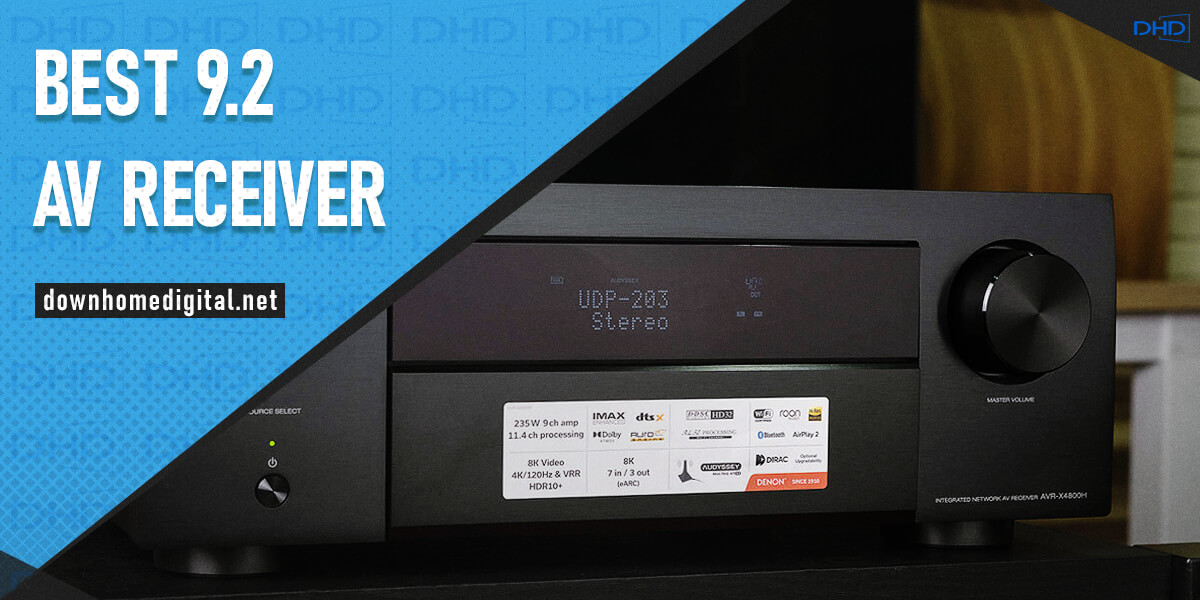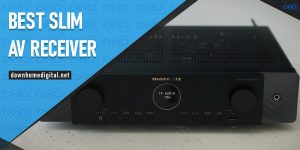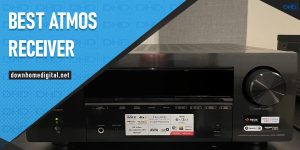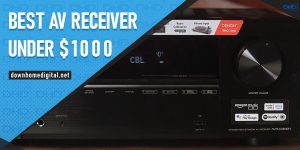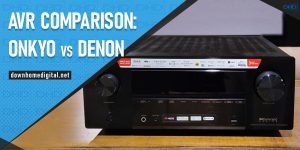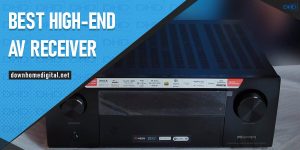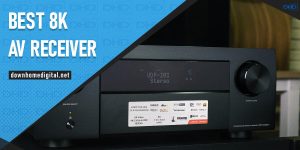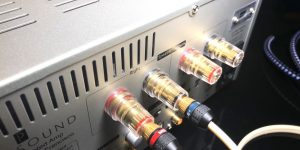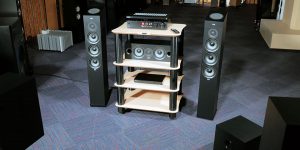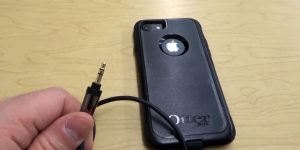Today, the home theater sphere has become considerably democratized. Gone are the days when you had to put aside some of your savings to make the long-awaited purchase. The range has diversified without sacrificing technical performance.
However, there are still models for connoisseurs willing to invest to enjoy a cinema-worthy installation. It is for this audience that this review was created. I want to help as much as possible to highlight all the pros and cons of the presented devices and help with choosing the best 9.2 receiver.
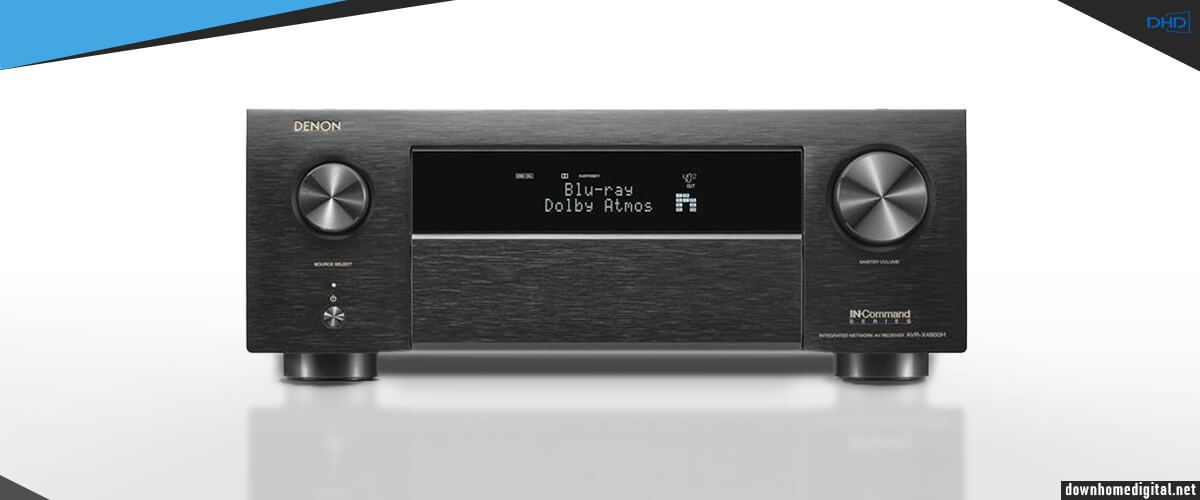
9.2 AV Receivers comparison table
| Name | Channels | Power output | HDMI in/out | Bluetooth/Wi-Fi | Review |
|---|---|---|---|---|---|
| Denon AVR-X4800H best overall | 9.2 | 150W/8 Ohm, 190W/6 Ohm | 8/3 | yes/yes | Review |
| Denon AVR-X3700H under $1500 | 9.2 | 105W/8 Ohm, 135W/6 Ohm | 7/3 | yes/yes | Review |
| Onkyo TX-RZ50 budget | 9.2 | 120W/8 Ohm | 7/2 | yes/yes | Review |
| Marantz SR7015 premium | 9.2 | 125W/8 Ohm, 165W/6 Ohm | 8/3 | yes/yes | Review |
Do I need a 3D home theater sound?
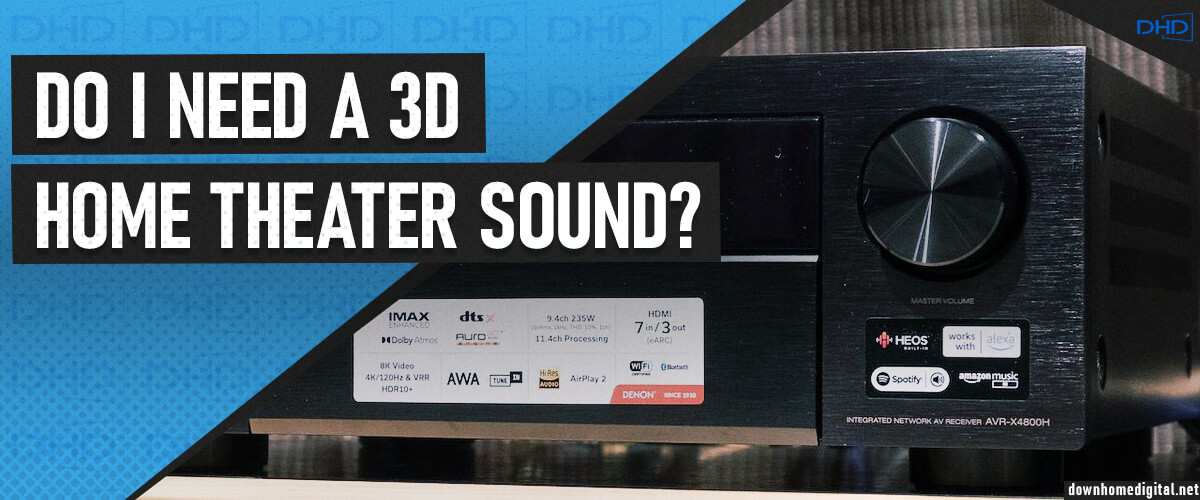
And since I decided to review models with outstanding characteristics made to create a real home theater, we must understand the need to have a crucial element of the home theater. Namely, 3D or surround sound.
Movie engineers use 3D sound to enhance immersion and the viewer’s auditory perception. In simple terms, sound comes from several different directions around the user, using several specific audio channels or dedicated speakers. And as you already know, almost all Blu-ray movies have a volumetric sound.
That is why the receiver must support at least configuration 5.1 to create a sound stage with the listener in the center. Alternatively, there may be 5.2.4 or 7.2.2-system support for even more immersive surround sound. But the 9.2 home theater systems are not only optimized for surround sound, and manufacturers often try to equip them with extended video capabilities and various additional features. First off, I will talk about the testing methods of the selected models and then proceed directly to the review.
How I picked and tested 9.2 receivers
Since I analyzed the selected models not only on the sound and video side but also on the general functionality side, it would be good to talk about my setup for these tests.
I used the following equipment for the test and I evaluated volumetric sound using the example of the movie Deadpool 2:
- CD player SACD 30n
- Blu-ray player Sony UBP-X700
- Speaker wire – AudioQuest Type-9
- Speakers for movie – Klipsch RP-8060FA
- Stereo speakers:
- Klipsch RP-6000F II
- KEF Q350
- DALI OBERON 5
I listened to the following tracks in different genres from different sources:
- Radiohead – The National Anthem – Spotify
- Bob Marley & The Wailers – Turn Your Lights Down Low – Deezer
- Arctic Monkeys – Do I Wanna Know – SoundCloud
- Led Zeppelin – Ramble On (CD player)
- The Weeknd – The Hills (CD player)
- Jacky Terrasson – Reach (CD player)
- Mark Nauseef – With Space in Mind (CD player)
- Mahler – Symphony No.2 (CD player)
I have a completely different configuration for evaluating surround sound. It comprises a Klipsch RP-8060FA set and a Sony UBP-X700 Blu-ray player. The speakers were connected to each receiver using an AudioQuest Type-9 cord, and I hope you already know how important a good connection is. So that was my kit, and now we’re getting to the fun part.
Mid-price 9.2 receiver reviews
Denon AVR-X4800H – best overall

Denon gives a special role to the X4xxx line of receivers. This series belongs to the premium segment, as it is made on a more advanced component base, comes in an ergonomic design, and is packed with various features. But at the same time, such models are sold worldwide and in large quantities. The popularity of this series is explained by the fact that you can deploy a large home theater for all modern cinema formats and audiophile music system on its basis. So let’s take a quick look at what the new representative of this series has to offer.
I’ll start with the receiver’s design, and I’ll tell you right away that in expensive ranges, you can see the unification of Marantz and Denon brands with the naked eye. AVR-X4700H, though a bit cheaper than the premium Marantz SR7015, presented in my rating, still looks like it, and even in the design, you can feel its high quality and reliability. I really like the LCD, which, unlike the round one in Marantz, is quite bright and easy to read, as well as the fact that all the buttons are hidden behind the panel, making them almost inaccessible to dust.
The Denon AVR-X4700H with nine amplification channels and dual subwoofer outputs can drive 5.2.4 or 7.2.2 channel speakers or in stereo at 125 W per channel at 8 Ohm or even 165 W at, and 200 W at 6 Ohm (on one channel). And those numbers are the maximum in my rating and identical to the premium Marantz SR7015.
However, significant changes were made to the video block. The Denon AVR-X4800H is among the first receivers to adopt the HDMI 2.1 standard with support for 8K at 60Hz. All HDMIs accept Dolby Vision and HDR10 +. However, only the main output is 8K with eARC and HDCP 2.3.
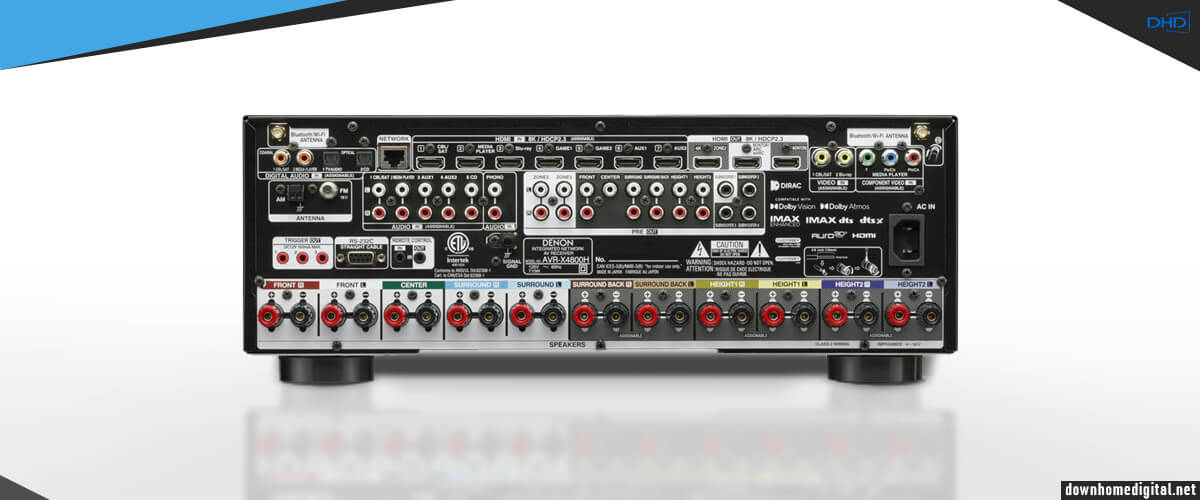
And I draw your attention to the fact that here we are entering the top speed of digital video requiring short 48 Gbps cords, at the risk of obtaining no image. Moreover, the AVR-X4800H decodes most of the modern surround sound formats:Dolby Atmos, DTS: X, Auro-3D, and IMAX Enhanced. And this is one of the main (but not the last) trump cards of this model.
Separately, the calibration attracts my attention. The Audyssey MultEQ XT32 is present with its procedure going through eight measurement points. However, the novelty of the AVR-X4800H consists of offering two distinct memories that can be recalled from the menus. It is thus possible to create a curve for films and another for music. That is not found in any competing device, even, for example, in the Marantz SR7015.
The AVR-X4800H has a built-in phono stage, all network and streaming playback features are implemented, as well as the multi-zone benefits of wireless HEOS. As I said above, Audyssey MultEQ XT32 is responsible for multichannel calibration and the sound quality in pure musical mode – an advanced digital platform D.D.S.C. HD Digital (includes audio processing AL32 Processing Multichannel, contains jitter suppression circuit, DAC Asahi Kasei AK4458VN) and seriously modified power system, which has a powerful shielded transformer and more capacitor “buffer.” By the way, the latter is made on custom high-quality electrolytes with a polyolefin dielectric.
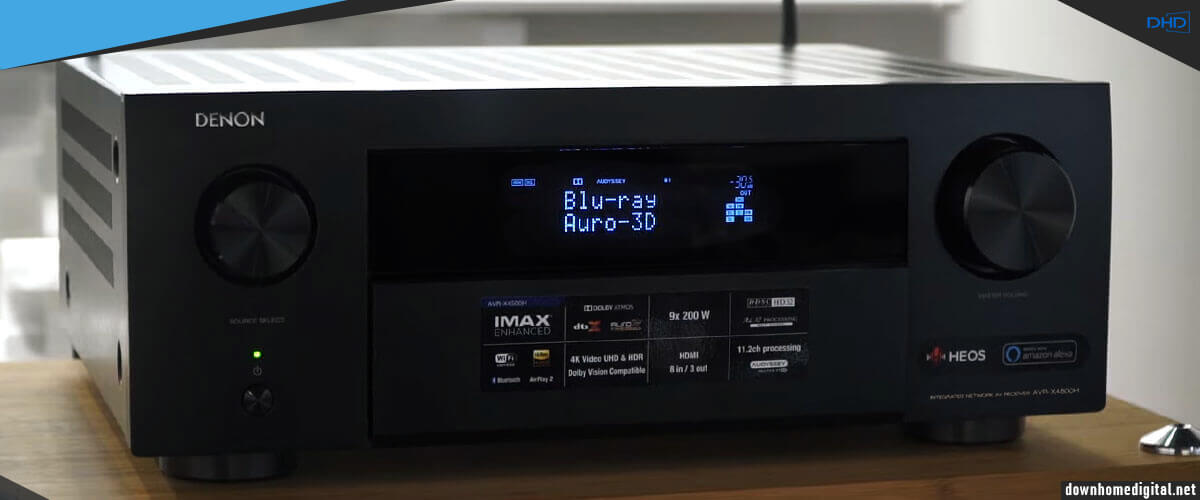
I started a test configuration with a subwoofer. When listening to music through the HEOS system and Tidal, I can say that the AVR-X4700H is doing with honors. In direct stereo without a subwoofer, I found my speakers’ sound signature, which received enough current to hold the membrane in the bass convincingly. The sound stage is wide and high, with good positioning of vocals and instruments.
Now, let’s move on to multichannel sound in my tests of the best 9.2 receivers. The film atmospheres are correctly transcribed, giving the impression of being at the heart of the action, surrounded by all the events. By default, the sound of Denon receivers is focused on voices but is already well-supplied with dynamic bass. I noted this fact well when watching A Quiet Place, where a little bit of dialog is spoken in whispers, and every little sound, whether it’s the rustle of leaves or the footsteps of the main characters, is important throughout the movie. It’s an amazing experience when you’re focused on watching rather than adjusting to quieter/louder. I was completely immersed in my experience.
Speaking of speakers, it’s worth mentioning that I tested the receiver in question with Klipsch RP-6000F II front speakers. The larger Tractrix hybrid horn and ceramic woofers made details in scenes more expressive, and I found this combination (speakers/receiver) to be excellent as they fit together perfectly. If you have the opportunity, I recommend definitely listening to what this pair sounds like.
Comparing the results of all the tests, this is a very balanced device, and I can say that Denon AVR-X4700H is the best 9-channel AV receiver on the market as it is very similar to the most expensive premium Marantz SR7015 while costing a bit less. You can’t say that this receiver is inexpensive, though. Not at all. Whether you’re a movie buff or an audiophile, you’ll be happy with lossless HD audio playback and high-quality surround sound with a full suite of Dolby, DTS, and IMAX technologies. This is a true Hercules among 9-channel receivers, as even its power matches the premium version of my rating. If you’re not used to saving money on yourself but want to save a couple hundred bucks to upgrade your speaker system, this is my recommendation.
| Power |
|
| HDMI features |
|
| Video features |
|
| Network |
|
| Surround sound processing |
|
Pros
- Highest power rating, like the premium Marantz SR7015.
- Audyssey calibration clarifies the sound stage, reinforces the center, and further improves the front/surround connection without the side and ceiling speakers.
- Virtualization of ATMOS ceiling speakers is really high quality and practically does not differ from real ceiling speakers.
- Support for all modern surround sound formats.
- HEOS.
- Supports video scaling up to 8K resolution.
Cons
- Bluetooth’s functionality sometimes loses previously connected devices from memory.
Denon AVR-X3700H – under $1500
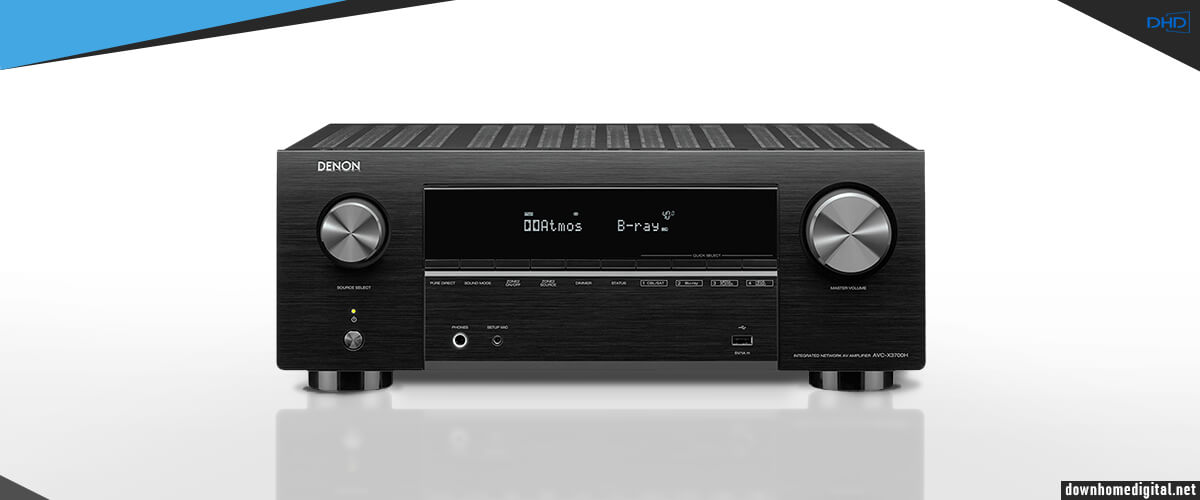
A representative of the Denon brand appears in second place in the mid-price category. I am a fan of this manufacturer in general, so this is not the last option in this review. The AVR-X3700H is a nine-channel device with 105 W per channel power at 8 Ohm or 135 W at 6 Ohm, which is much cheaper than Denon AVR-X4700H. In fact, you have a choice of configuration. However, the AVR-X3700H can handle 7.1.4 channels simultaneously. For this, outputs with pre-amplification are here, counting on the addition of an external stereo power supply.
Even though AVR-X3700H has a standard design for the brand, unlike AVR-X4700H, all its controls are located on the body. However, I can’t say I felt much difference in controls and buttons; everything is well made.
I would like to point out that this Denon has the latest sound standards. It can decode Dolby Atmos and DTS: X as well as IMAX Enhanced. And another helpful feature is the presence of DTS Virtual: X technology and Dolby Height Virtualization Modes to simulate ceiling speakers.
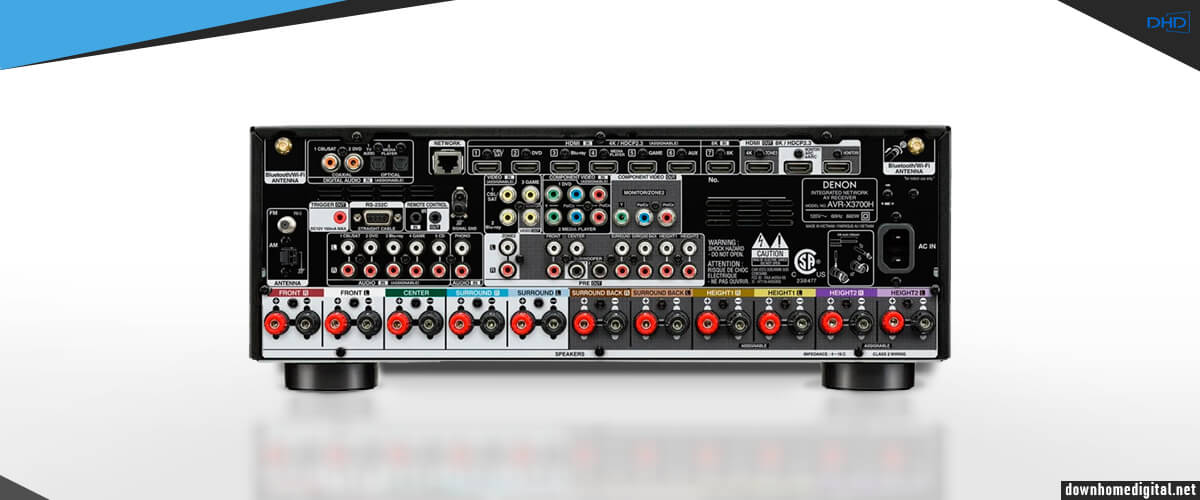
The situation is also good with video capabilities. Here you can see 8K compatibility via HDMI 2.1 input and output. In addition, most standard video technologies are present here, such as HDR 10+, which the Denon AVR-X3600H did not have.
I was impressed by this 9.2 surround sound receiver`s sound. The AVC-X3700H recreates a feeling of an enjoyable and genuinely immersive sound environment. The excellent link is there between the fronts and other speakers with effects. There is at no time a cut between the two zones, which is one. Within this three-dimensional space, the sound objects move entirely freely.
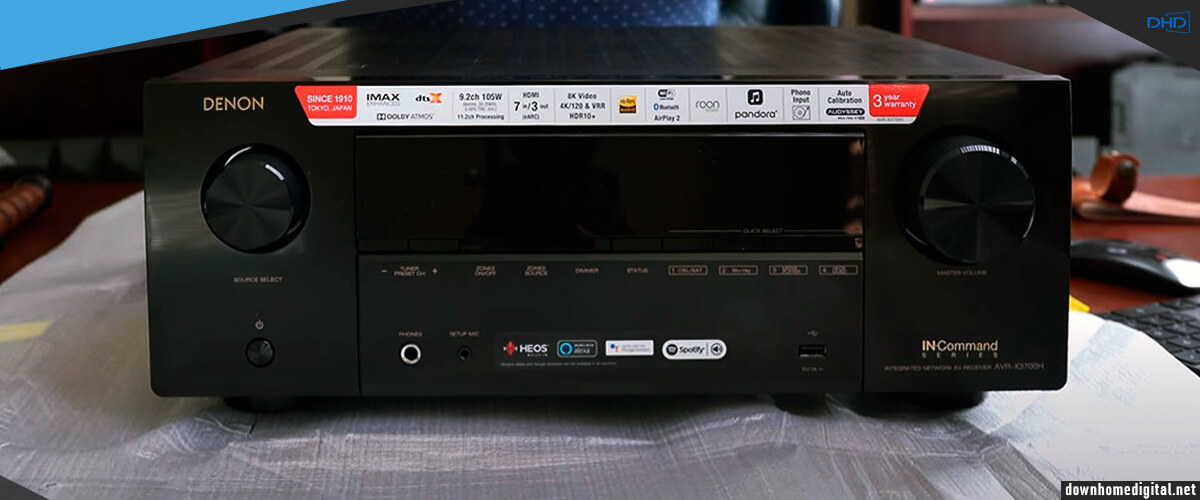
In Deadpool 2, in battle scenes where sounds spring up from above or across the room in front of us, between the fronts and surrounds, the 3700 masters its subject and place the elements where they need to be.
Denon AVR-X3700H is a great representative of the middle segment and the most inexpensive among them. So you can safely make it the center of your system. It pleasantly surprised me with its performance in both music and movie playback. It handles video streaming wireless audio streaming and holds a three-dimensional soundstage perfectly. If you or your household are gamers, it will suit your needs quite well. For me, this is the dominant mid-priced model among 9.2 receivers under $1500, with support for 8K/60Hz and IMAX Enhanced for real movies.
| Power |
|
| HDMI features |
|
| Video features |
|
| Network |
|
| Surround sound processing |
|
Pros
- This model is suitable for modern gaming, as it reproduces images of 4K/120Hz.
- Bi-amplification is available.
- Great connection between the fronts and other speakers with effects.
Cons
- The sound distortion appears at high volumes.
Marantz SR6015
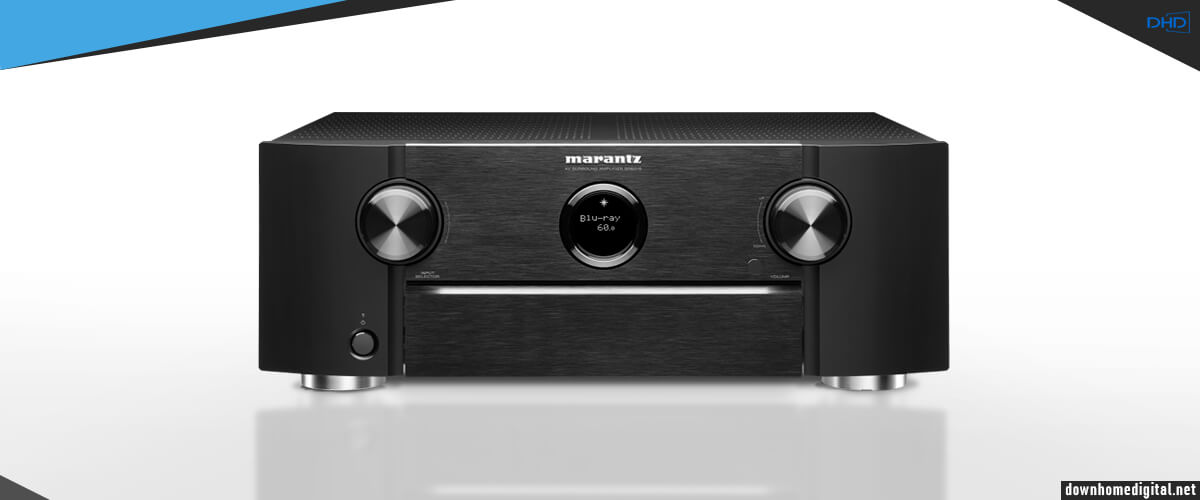
Next on my list is the Marantz SR-6015. This receiver uses high current-carrying discrete component amplifier circuits. Thus, it can deliver 220W per channel at 6 Ohm or 2 x 110 watts into 8 ohms in stereo, which is a perfect figure for a mid-budget 9.2 channel receiver. The SR-6015 has the latest immersive multi-channel audio decoders. It can broadcast Dolby Atmos and DTS: X audio streams.
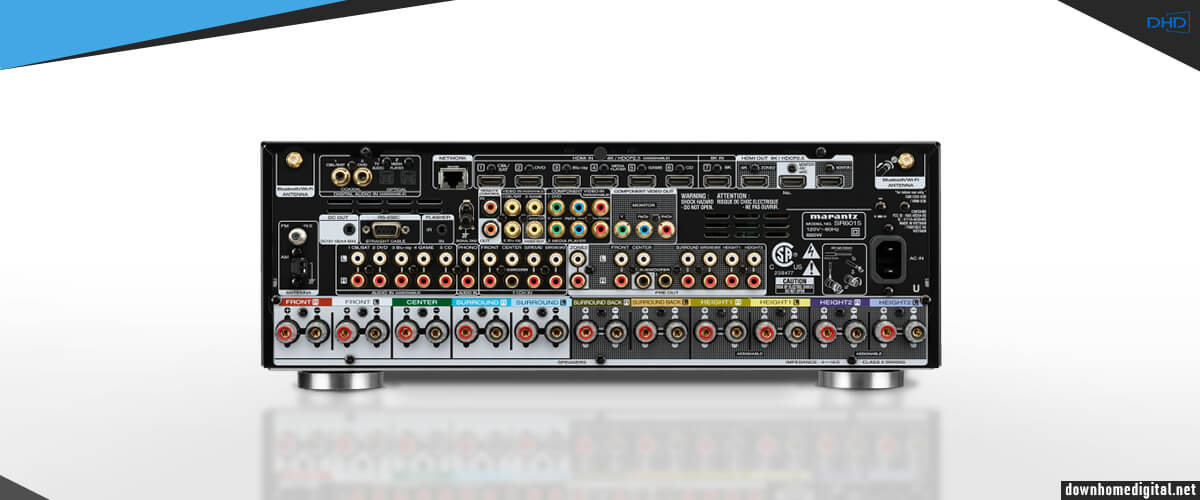
The SR6015 did a magnificent job with my test system. The first listening without calibration gives a calm, even, very nice sound stage. Whether it’s multichannel listening or stereo music, the SR6015 doesn’t have aggressive highs or dominant lows.
The SR-6015 is priced between the Denon AVR-X3700H and Denon AVR-X4700H, and just like them, it can expand systems up to 11 channels with an external amplifier. However, Marantz is always about unrivaled internal component quality. So yes, it is in the mid-price category, but only 1 of its 7 HDMI inputs has version 2.1 (the receiver was released in 2020).
Nevertheless, its solid construction can be felt in the smallest details. Even all the front panel controls are hidden under the cover, which I’ve already noted as a bonus. But I’m not crazy about the round screen, which is undoubtedly pretty, but if you’re further than 10 feet away from the device, you won’t be able to see anything on it.
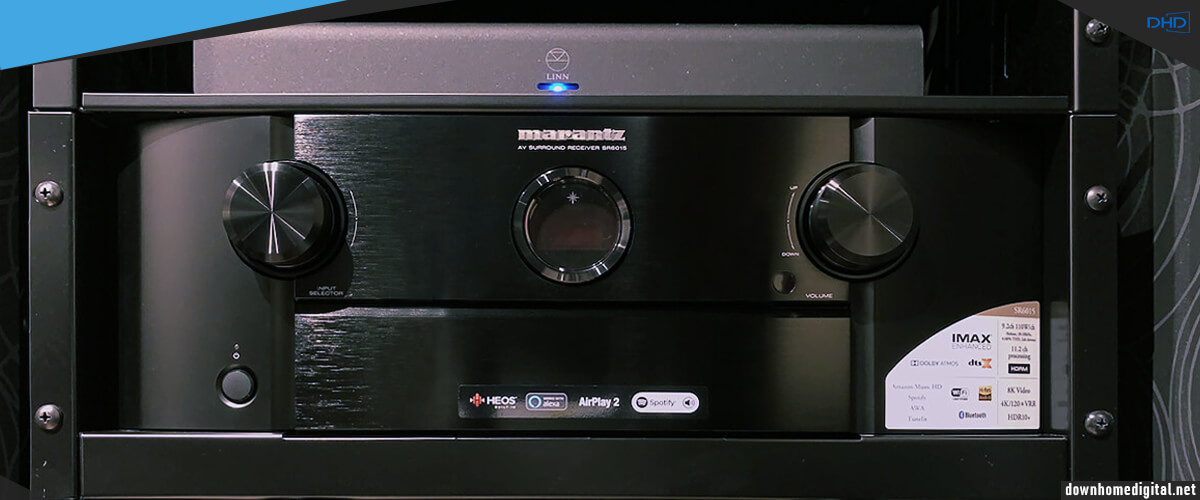
The SR6015 did a magnificent job with my test system. The first listening without calibration gives a calm, even, very nice sound stage. Whether it’s multichannel listening or stereo music, the SR6015 doesn’t have aggressive highs or dominant lows. And while I’m not a fan of chasing brands, I can’t help but appreciate the warmth and brightness of the Marantz, especially in the jazz, blues, or classic rock genres. With a well-matched speaker system, few brands can match it in conveying an atmosphere that makes you want to close your eyes, immerse yourself in the coziness of a basement bar with dim lights, and enjoy the reality of a guitar, sax, or piano.
After going through Audyssey MultEQ XT32 calibration, the changes were quite significant. In a positive sense, of course. Here, I was able to enjoy the volumetric sound in the film entirely. The subwoofer is perfectly synchronized with the rest of the unit and gives deep bass, explosions and other special effects that are “physically” felt. Everything was set up perfectly automatically, there was nothing to tweak. I also want to note that the receiver perfectly reproduces dialogues through the center speaker.
With the price and functionality that the Marantz SR6015 offers us today, I can safely put it in my rating list of the best 9-channel receivers. It is inferior to its predecessor from Denon lines in some parameters (it is not as powerful as AVR-X4700H and has only 1 HDMI with 8K), but the quality of its construction will spare you the thought of upgrading for years to come. It will satisfy most people looking for a modern device that can immerse them in movie soundtracks, as it lives up to the expectations of almost all Atmos and DTS: X systems. However, it does not have Auro-3D decoding and only 2 zones for audio and video transfer. Choose Marantz if you’re committed to unrivaled quality and the most realistic sound possible in immersive and stereo formats.
| Power |
|
| HDMI features |
|
| Video features |
|
| Network |
|
| Surround sound processing |
|
Pros
- Has the ability to expand the system up to 11 channels (Denon AVR-X3700H and Denon AVR-X4700H).
- A large number of inputs support HDMI 8K and/or dual 4K outputs, eARC, etc.
- The wireless network is easy to set up and very responsive.
Cons
- Only one HDMI version 2.1 input for 8K video.
- HDMI CEC does not work correctly to control basic device commands such as ON/OFF.
Budget 9.2 receiver reviews
Onkyo TX-RZ50 – budget
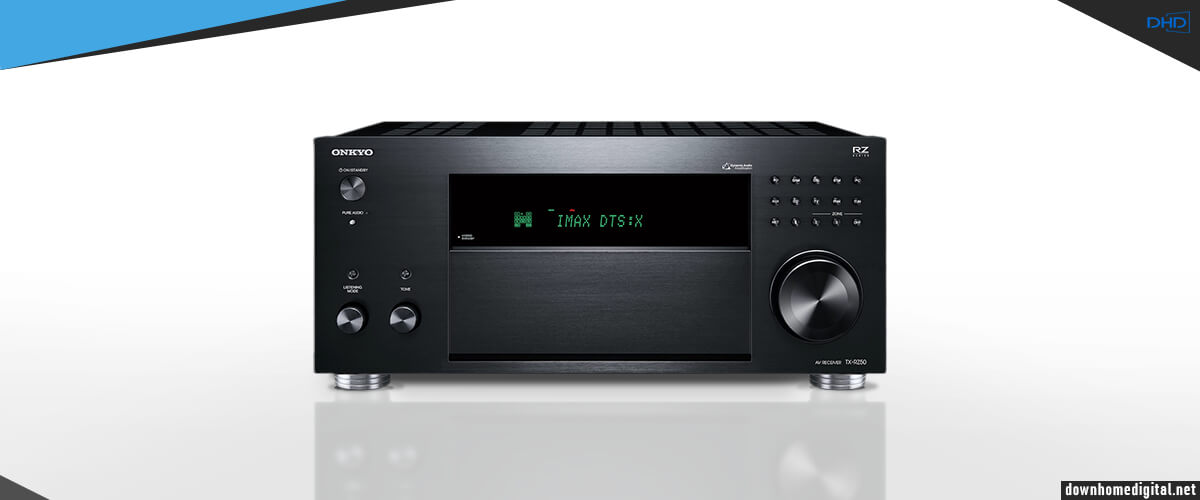
The first model on my list in this segment is the Onkyo TX-RZ50. Despite its budget price, this receiver is the flagship of the brand’s lineup. Still, most importantly, it can offer superior functionality, for example, support for 8K/60Hz video resolution and the ability to expand the system to an 11.2 configuration. And this is what makes it most advantageous compared to Denon AVR-X3600H and Onkyo TX-NR797, but also the most expensive in the budget category.
So, with the TX-RZ50, you can build a 7.2.4 home theater configuration for the most optimal Dolby Atmos, with 120 W/Ch power (8 ohms, 20 Hz-20 kHz, 0.08% THD, 2 ch). Of course, it is inferior in sound clarity to more expensive models at maximum volume, but the receiver sounds great if you do not turn the volume up to maximum. By the way, Onkyo has a very good range of speaker adaptability from 4 to 16 ohms.

You can simultaneously broadcast video and audio in a Multi-room system (2 Zones for video and 3 Zones for audio). You can also use wireless streaming with several options, including Sonos (but you’ll need to buy a dedicated port separately), Chromecast built-in, AirPlay 2 and DTS Play-Fi, or control voice assistants via Wi-fi and Bluetooth. The receiver already has built-in streaming services, which you can use with the free Onkyo Control App, which works for both Apple and Android.
As for connection options, you can connect game consoles, a vinyl player (there is a built-in phono stage), various devices via the USB port, and even old equipment.
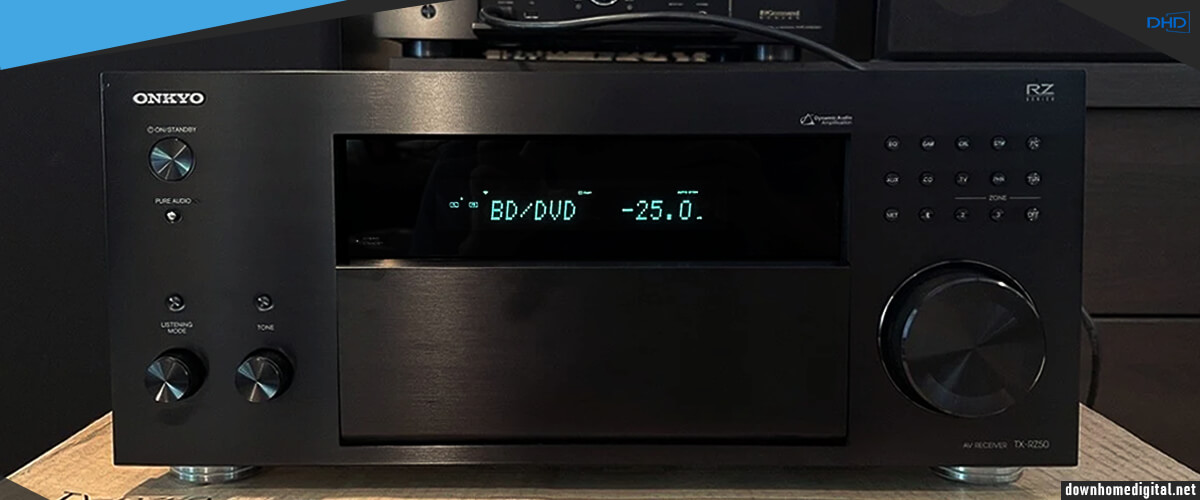
With Onkyo TX-RZ50, you can enjoy content in 4K/120Hz mode (I mentioned 8K support at the beginning of the review) for modern video formats HDR10+ and Dolby Vision. And special mention should go to IMAX Enhanced mode, optimized for proper 4K HDR and Ultra HD Blu-ray processing, as well as allowing you to enjoy perfect DTS:X audio streaming.
It’s fair to ask why you should pay attention to more expensive models when there’s the TX-RZ50 with extensive functionality. I’ll answer simply – the build quality of the construction. Despite its mega-popularity, Onkyo cannot replicate the experience of Marantz or Denon (or rather, they don’t want to) by targeting the average consumer. The brand offers more features at the expense of saving on external and internal components, which becomes apparent over time. I don’t really like its front panel controls; the buttons don’t feel solid. But the remote control doesn’t help either, as it is pretty primitive, and most of the features don’t work like the above models (constant freezing, delays, and bugs).
You will have to pay a bit more compared to other budget segment devices, but the price of the Onkyo TX-RZ50 is still quite reasonable, especially considering its wide range of features. With all the bells and whistles, it’s hard to find a model that compares to this one, and that’s why I call the TX-RZ50 the best budget 9.2 receiver.
But I’d like to point out again that some of the claimed features don’t work properly, the overall sound picture is much inferior to representatives of more expensive categories (let’s just say it’s simpler), and the receiver’s design won’t last as long as a Denon or Marantz. So, if you value functionality more than reliability, this is a great option for your home theater.
| Power |
|
| HDMI features |
|
| Video features |
|
| Network |
|
| Surround sound processing |
|
Pros
- The ability to expand the system to 11.2.
- HDMI 2.1 with 8K/60Hz support for Zone 1.
- Supports advanced video and audio modes.
- THX certified.
- IMAX Enhanced support.
Cons
- You must purchase additional devices to maximize the receiver’s capabilities.
- The buttons don’t feel reliable.
- The controls are rather primitive.
- Most of the functions do not work like the above models (constant freezing, delays, and bugs).
- There is interference at maximum volume.
Denon AVR-X3600H
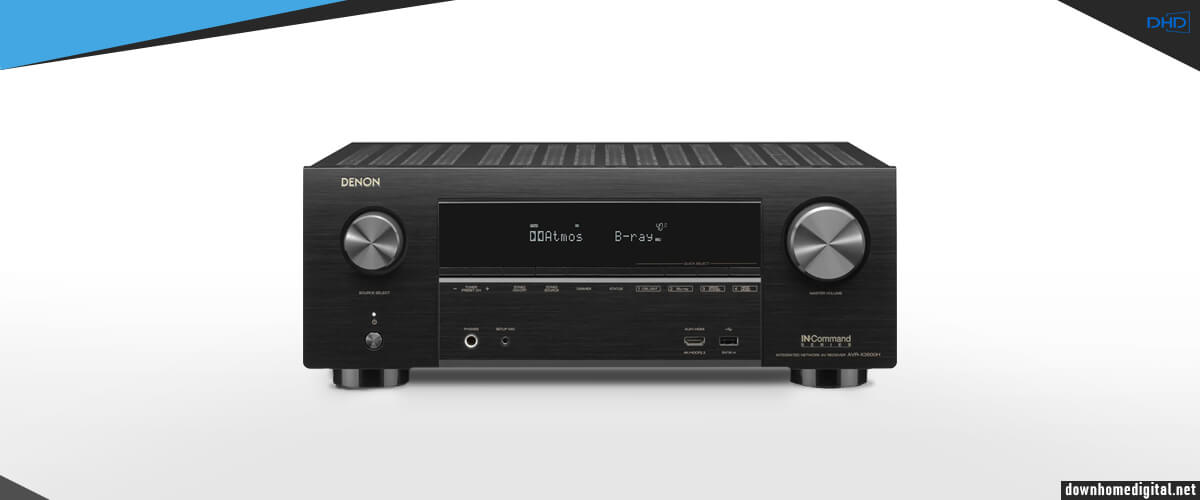
Suppose we talk about alternatives when quality and functionality correspond to the budget, and you can be sure of the durability of the equipment. In that case, you should pay attention to Denon AVR-X3600H as a representative of the 9.2 receivers up to the $1000 segment.
Thanks to digital amplifiers for each channel, the device received 125W power at 8 Ohm or 165W at 6 Ohm, or 235W at peak and stable operation with good quality indicators even with low impedance acoustics. This offers the opportunity for some savings when choosing a home theater speaker.
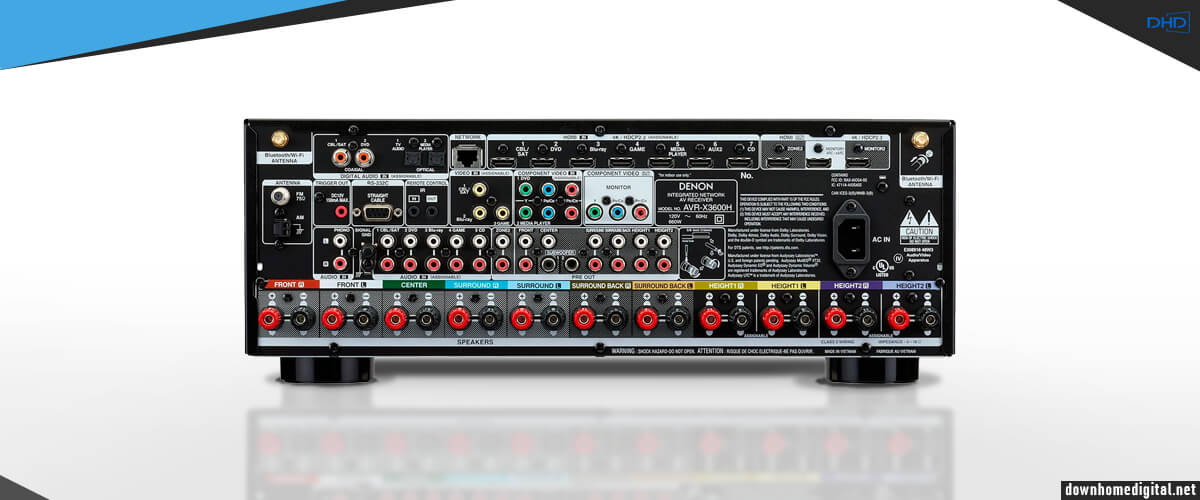
The AVR X3600H receiver has an advanced video section with an impressive calibration set of compatibility with the new HD and Ultra HD TV panels. The unit provides multi-channel audio transmission directly from the TV panel over the extended eARC audio channel. It incorporates image optimization technology – Dolby Vision, supporting dynamic brightness expansion – HDR version 10 and HLG, which provides clarity, brightness, and remarkable detail. But since the model was released in 2019, it only works with 4K video resolution.
Besides, the support of Dolby Atmos and DTS surround sound technologies is implemented in the device, completely immersing me in the thick of events taking place on the screen with the realistic soundtrack. I liked that it creates a pretty real immersive experience. In addition, you have the option of expanding the system up to 11 channels.

And I can even argue that the sound quality is at the level of premium models, and the sound is close to ideal, both when watching a movie and when listening to music. The 32-bit DAC of the top brand AKM AK4458VN by the Asahi Kasei Microdevices provides impressive processing power, which allows it to produce a good sound, I cannot say the same for the Denon AVR-X3700H.
In my opinion, the Denon AVR X3600H review showed that the device is ideal for those who care more about quality than functionality. With absolutely insignificant expenses based on your home theater, you will get a device that sounds confidently in immersive and stereo formats with wide audio capabilities (system expansion up to 11 channels, 2 zones of video and audio broadcasting, confident wireless signals). The trade-offs that await you with AVR X3600H are quite acceptable to me, as they involve 4K video (instead of 8K), a limited number of features compared to more expensive models, and some other minor drawbacks. In terms of sound characteristics it clearly outperforms its competitors from Onkyo.
| Power |
|
| HDMI features |
|
| Video features |
|
| Network |
|
| Surround sound processing |
|
Pros
- It is possible to create a multi-room chain using HEOS and AirPlay 2.
- High-resolution audio playback in FLAC and DSD formats is lossless.
Cons
- Only 4K video is available.
- Music from streaming services such as Amazon Music and Tidal does not play well.
- The receiver has a poor Wi-Fi network reception and a slow data transfer rate.
Premium 9.2 receiver reviews
Marantz SR7015 – premium
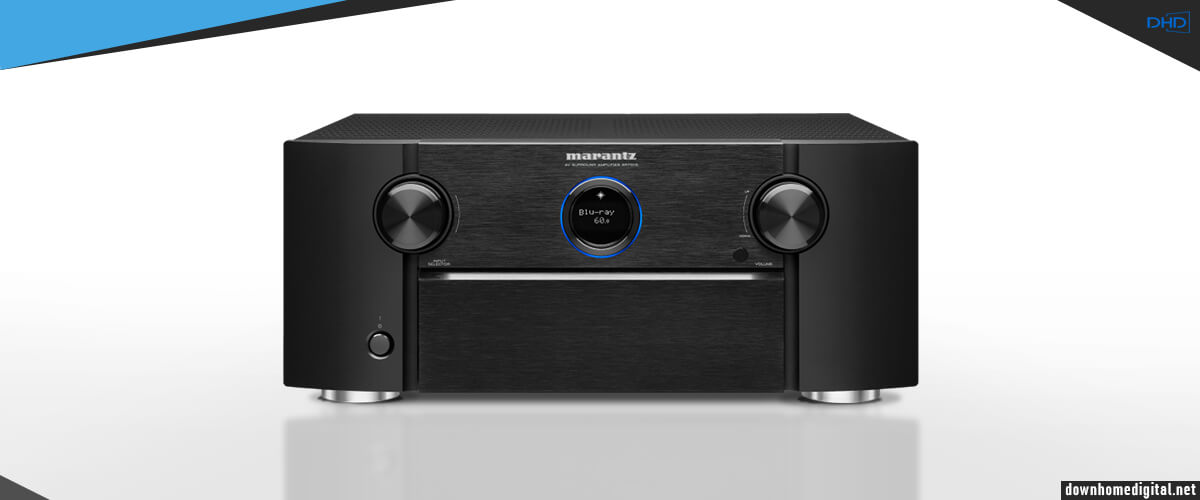
Now we will talk about receivers from the premium segment. The Marantz SR7015 is one of those. This model organically combines the signature features of the appearance in its large body, and the competent implementation of the front panel gives it harmony. In the center is a small round display with a switchable blue backlight, on which, frankly, it is difficult to discern anything. It most likely carries more of an aesthetic load than a functional one. On the sides of the display, there are two selectors with basic functionality: the volume knob on the left and the input selection on the right. In fact, externally, it’s not much different from the already described SR6015, but its construction is heavier, which means it has a huge amount of power under the hood (it weighs 31.3 pounds), as evidenced by its cost.
In my opinion, such display design is deliberate because apart from the menu, which SR7015 can display on the TV screen, there is another bigger and much more informative display hidden behind the flap on the front panel. You can also access some function buttons and “hot” connectors there: USB port, HDMI, headphone and microphone jack for the audio autocalibration system, and three RCAs for analog audio/video signals.
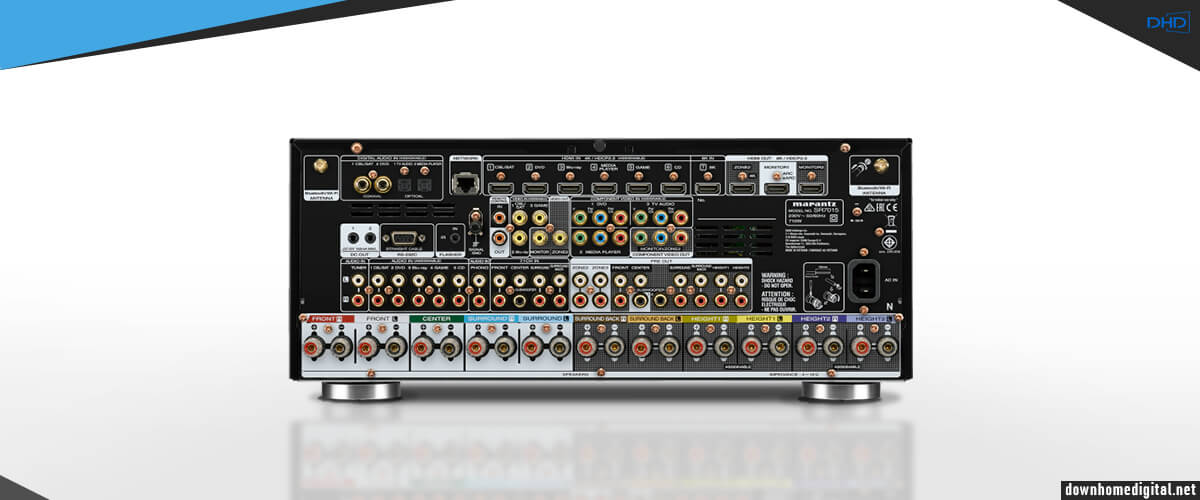
The SR7015 has a huge number of inputs and outputs, as it befits a top-level receiver. Let me immediately specify that the Marantz SR7015 has 11 pairs of terminals on the rear panel to connect the speakers, but there are 9 amplifiers inside. The processor can process all 11 channels of surround sound, but only nine will sound simultaneously, depending on the surround mode set and the specific configuration chosen. If you need to use all 11 channels simultaneously, you can use the amplifier with a loop-through channel. It is also possible to activate the Bi-amping mode by reassigning a pair of built-in amplifiers to help the main speaker.
The Marantz SR7015 has 8 HDMI connectors for incoming and 3 for outgoing signals. One of the HDMI inputs and two HDMI outputs support 8K/60Hz and 4K/120Hz video resolutions. One of the outputs also has eARC support. All other HDMI outputs support 4K/60Hz and many other useful protocols: HDR10/10+, HLG, Dolby Vision, ALLM, VRR, QMS, and QFT. Of course, there are optical, coaxial ports, and others for connecting the old equipment, but I won’t dwell on them. Crowning the back panel are two antennas on the sides – for interaction with devices via dual-band Wi-Fi (including support for Apple AirPlay 2) and Bluetooth.
HEOS multimedia technology provides a convenient control app and access to various music services: Spotify, Tidal, Amazon Prime Music, and more. In addition, the SR7015 works with Amazon Alexa and Google Assistant voice assistants as well as Siri, thanks to AirPlay 2. As a result, you can “ask” the device to play your favorite music, turn up the volume, skip to the next track, switch inputs, and more.

As for surround sound, this “universal soldier” supports Dolby Atmos, DTS:X, and Auro-3D formats (with up to 11.2 channels processing capability) and is IMAX Enhanced certified.
I think it’s important to mention that Marantz does not change its traditions in terms of sound. HDAM modules have sworn Marantz for 25 years, and it is not without reason. In Pure Direct stereo mode, the SR-7015 has a typical Marantz warm tone that is immediately noticeable. The same sound that I know well since.
Switching to Multi-Channel Stereo mode, the source, of course, remains stereo, but the sound is distributed throughout the room through all the speakers, showing that the Marantz SR7015 can produce a very believable simulation of multi-channel sound what the Denon AVR-X4800H lacks. It may not be entirely realistic for an audiophile, but it is immersive and delightful. Here I can note an even wider sound stage. Sound objects move naturally. In Cinema mode, voices are even more profound and richer.
Marantz SR7015 can do everything or almost everything! Even the audio output terminals are gold-plated because this is premium equipment. You’ll be able to connect all your equipment to it, and you’ll still have jacks to spare. The receiver will provide a balanced sound for a large room, so it’s perfect for a large family. You’ll also be able to split into zones (3) if you’re presenting your evening differently. It has everything top-notch – video, sound, and functionality. On my list, this is the most optimal option for those who are not tight on funds and want a full-fledged, top-tier home theater that simply has no competitors on my list.
| Power |
|
| HDMI features |
|
| Video features |
|
| Network |
|
| Surround sound processing |
|
Pros
- Support for modern surround sound formats.
- Ability to work with 8K/60 Hz and 4K/120 Hz video.
- Variety of additional functions (multi-room, voice control, etc.).
- Extensive connectivity.
Cons
- The headphone jack is behind a hinged cover on the front panel, which is not convenient.
Discontinued models
Onkyo TX-NR797
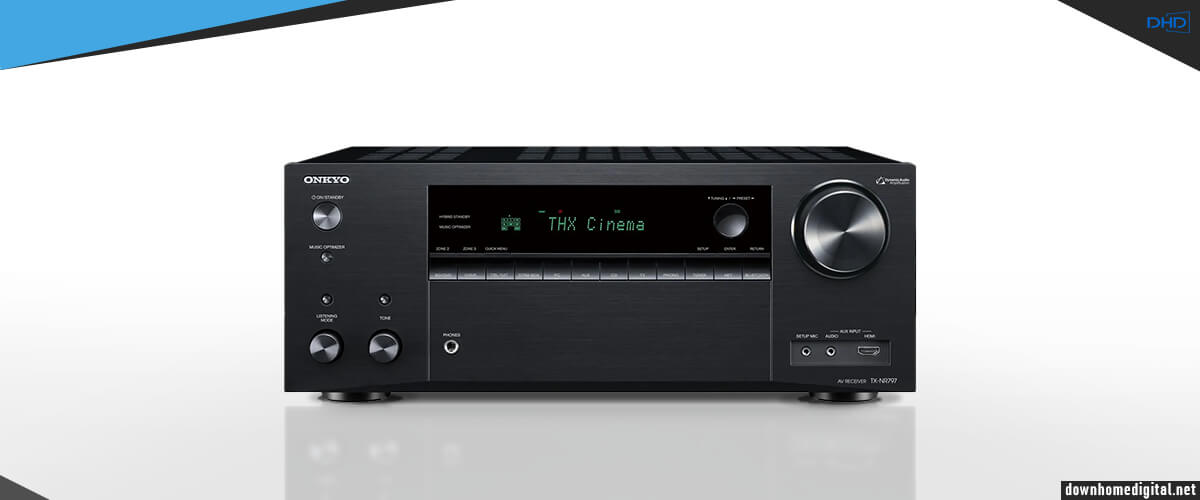
And the last one on my list is the Onkyo TX-NR797. By the way, this is the first Onkyo receiver to be released under the IMAX Enhanced program. Today, this model is out of production, but it is still quite possible to buy it. So read my review of TX-NR79, and I advise you to hurry up and buy it (if you are interested) because, first of all, the price is reduced, and secondly, it may soon disappear from the shelves.
There is practically nothing to note about the receiver’s appearance, except, perhaps, that all the necessary connectors for quick access (headphones and an additional HDMI port) are located on the front panel, which pleased me as a tester. But the remote with its rubberized buttons – not at all. Despite its simplicity, I know what will happen to these buttons over time, and I’m horrified by the experience. All the dust, fine hairs, and grease from my fingers will stay on it forever. The good thing is that even now, you can buy replacements inexpensively. The screen is large but not bright, so I can’t give it a plus either.

This device is THX Select certified, compatible with Dolby Atmos and DTS: X audio formats, as well as 3D sound virtualization technologies, enhanced audio distribution, and 4K HDR support. That is why it plays surround sounds in 5.2.4 channels or 7.2.2 rear envelopes and develops 100W at 8 Ohm, or 220 W at 6 Ohm. And this is the standard set for this price range. But it’s the only receiver in my rating that doesn’t have an expansion to 11 channels.
TX-NR797 provides immersive DTS:X audio decoding, optimized to perfectly reproduce the full dynamic range of IMAX audio mixes.
This new IMAX Enhanced mode is designed to reproduce IMAX audio, as the filmmakers originally intended. It’s perfectly in sync because the enhanced IMAX audio has been programmed to handle 4K HDR and Ultra HD Blu-ray properly. And I must tell you that the technology fully copes with its task. There were such sensations as in a professional cinema when watching a movie, and the sound environment was fully felt.
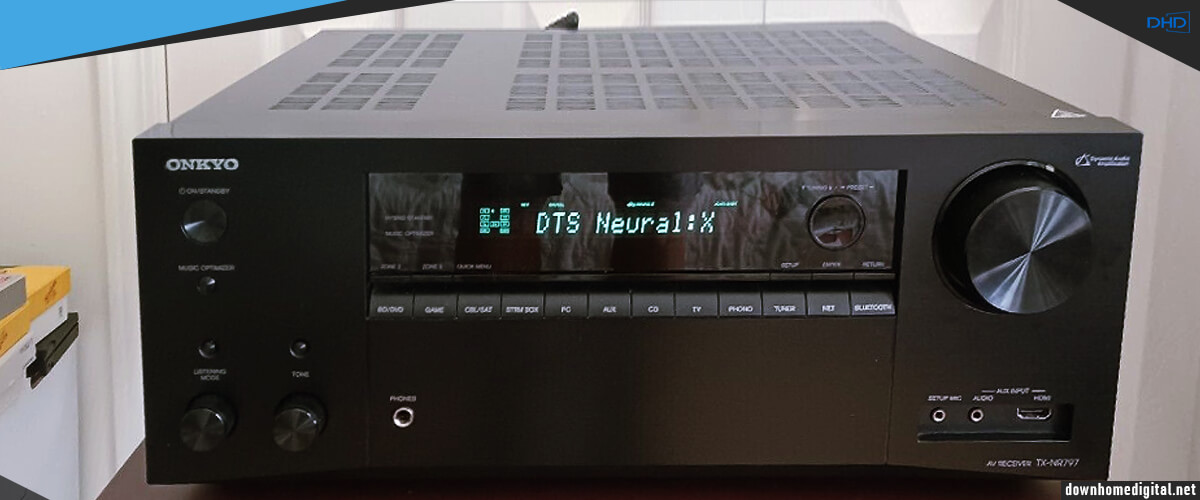
On the other hand, the playback of audio recordings did not make such an impression on me, but still – the receiver sounds good. I cannot single out any apparent flaws in the sound. I can say for sure that the sound stage is wide and the sound itself is pretty detailed.
Onkyo TX-NR797 is a good and inexpensive receiver with advanced features such as multi-room up to 3 zones, Wi-Fi 5 Hz, and THX certification. Yes, it is inferior to many reviewers (including the budget Denon AVR-X3600H) in terms of sound quality and power, but that makes up for its price. Its sound is simpler than Denon’s, without warmth and dynamism, but still, THX Select certification is not awarded for nothing. If you add the IMAX Enhanced mode I described, you can quite expect a decent sound, especially if you are not versed in the nuances.
In a word – this is quite a decent device for its money for unassuming viewers, with basic functions for viewing modern content, including 4K video.
| Power |
|
| HDMI features |
|
| Video features |
|
| Network |
|
| Surround sound processing |
|
Pros
- The initial setup is quick and easy. Everything is intuitive.
- Immersive DTS:X audio decoding, optimized to perfectly reproduce the full dynamic range of IMAX audio mixes.
Cons
- The Bluetooth interface works stably over long distances. To get good sound, the devices must be as close as possible.
- Smallest capacity in the ranking.
- The stereo sounds pretty flat, losing out to other even budget models.
Buyer’s guide
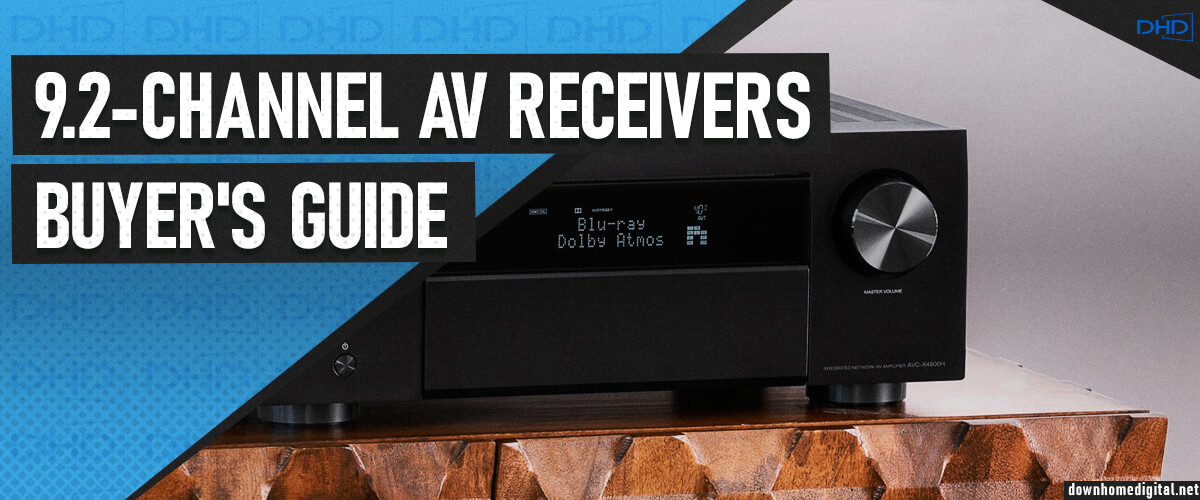
How much power per channel do you need?
An essential step in choosing a receiver is to determine the required power. This is a delicate point to which I draw your particular attention, as lack of power affects the final perceived sound quality.
And the first thing to do to determine the required value is to look at the impedance of the speakers we are going to install and select the receiver power we need based on that impedance.
For example, values between 120 and 150 watts per channel are generally sufficient for powerful and impressive sound in rooms less than 30 square meters. They are influenced by many more factors, such as speaker sensitivity, room acoustics, etc.
Pay attention to your connections
Another key point when buying our receiver is to see what types of connections it has and in what quantity. Usually, there are many analog and digital inputs, the latter being optical and coaxial or HDMI. However, it is always advised to think about how much equipment we want to connect (DVD, Blu-ray, game console, DTT receiver, computer, TV, etc.) and with which type of connection more or less to calculate the inputs and outputs that we need.
How to add music to other rooms?
And I will mention another helpful feature that I find very useful – this is multiroom. Multiroom allows you to connect a second set of speakers (some models have support for multiple stereo pairs and a 5.1 set) in a different room that can play content independently of the primary audio source. Modern receivers can do this using a wired connection through dedicated channels. In addition, there are wireless technologies such as HEOS or AirPlay 1/2 with which you can create a multi-room environment.

